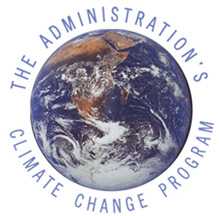"We're going to identify what it takes to
make the White House
a model for efficiency and waste reduction, and then we're going
to get
the job done."
President Bill Clinton
The White House, which recently celebrated its 200th birthday, has a long
tradition of demonstrating technological innovation. In keeping with that
tradition, President Clinton announced the Greening of the White House
Initiative on Earth Day 1993. The initiative improves the energy and
environmental performance of the White House complex by identifying
opportunities to reduce waste, lower energy use, and make an appropriate
use of renewable resources, all while improving indoor air quality and
building comfort.
The Greening of the White House Report, on President Clinton's legacy of
greening at the White House, summarizes progress made to
date and gives an overview of new opportunities identified during the past
year. It also includes an environmental history of the
White House and a short tour of the buildings that make up the White
House
complex. Over the past five years, this initiative has involved
hundreds of
dedicated people from both within and outside government. A
description of
how they worked together to develop and implement the Greening Plan
is also
included in the report, along with a number of helpful resources.
Many of the steps identified during the first two years of the
Greening Initiative
were implemented. The Second Annual Report, issued in March 1996,
estimated savings of more than $150,000 per year in energy and water
costs,
landscaping expenses, and expenditures associated with solid waste.
White
House Greening measures completed since 1996 are saving an
additional
$150,000 each year, for a total of approximately $300,000 annually.
These new
projects, together with original measures, are also avoiding
atmospheric
emissions of at least 845 metric tons of carbon every year.
The Greening Plan can decrease White House energy and water
consumption by
50 percent or more. It also supports President Clinton's leadership
role in
protecting the environment. The Greening of the White House project
creates an
environmentally sustainable White House and a world-class
environmental
showcase.
The White House has been described as the house of the people. In
that sense,
this work is not just about the White House, it is about your house.
Many of the
steps identified and implemented in this report make good economic
and
environmental sense for many Americans. Hopefully this report will
provide you
with the ideas and inspiration to make your home, office, or
business more
energy efficient, environmentally sound, and comfortable.
The Program's Start
The President's Council on Environmental Quality assembled a team of
experts
that included members of the American Institute of Architects, the
U.S.
Department of Energy's Federal Energy Management Program (FEMP), the
U.S. Environmental Protection Agency, the General Services
Administration, the
National Park Service, the District of Columbia, the Executive
Residence Staff,
the White House Office of Administration, and the Potomac Electric
Power
Company. The team oversaw a comprehensive energy and environmental
audit.
In addition, the team participated in a greening design workshop
that produced
recommendations to preserve the historical presence of the structure
and
maintain (or improve) comfort and productivity.
More information can be found regarding the history of the Greening
of the
White House on the Center for Renewable Energy and Sustainable
Technology
Web site.
White House Upgrades
The White House upgrades represent an ongoing effort to cut waste
and
improve energy efficiency throughout the complex (the Executive
Residence, the
Old Executive Office Building [OEOB], and the White House Grounds).
Since
beginning the upgrades at the White House, similar upgrades have
been made at
other Federal facilities, including the Pentagon and buildings at
the Grand
Canyon.
The Greening measures fit into seven categories:
- Building Envelope: A significant amount of energy is lost
through the
roof, windows, and walls of buildings, so those areas were
analyzed for
options to increase efficiency.
- Lighting: Energy-saving light bulbs were installed
wherever
possible, and
steps were taken to ensure lights are turned off in rooms that
are not in
use. Maximizing the use of natural light was a priority,
because it's free
and more visually pleasing.
- Heating, Ventilation, and Air Conditioning (HVAC):
Measures
were
sought to reduce the amount of energy used to heat and cool the
buildings
while simultaneously increasing occupant comfort. Improving
indoor air
quality and reducing the use of paint with volatile organic
compounds are
also major goals.
- Plug Loads: Energy-saving office equipment was
installed, and
refrigerators and coolers were replaced with more
energy-efficient
models.
- Waste: After analyzing the waste being generated, a
comprehensive
recycling program began for aluminum, glass, paper, newsprint,
furniture,
batteries, fluorescent lamps, paint solvents, and laser printer
cartridges.
Organic yard waste is recycled at an off-site composting
facility.
- Vehicles: Many leased vehicles accept cleaner-burning
alternative fuels,
and the White House is participating in a pilot program to test
electric
vehicles. Also, many employees use public transportation to
decrease the
use of automobiles.
- Landscaping: Methods to reduce unnecessary water and
pesticide
use
and increase organic fertilizers on the grounds of the complex
were
analyzed.
For more information on Greening
of the White
House



![]()